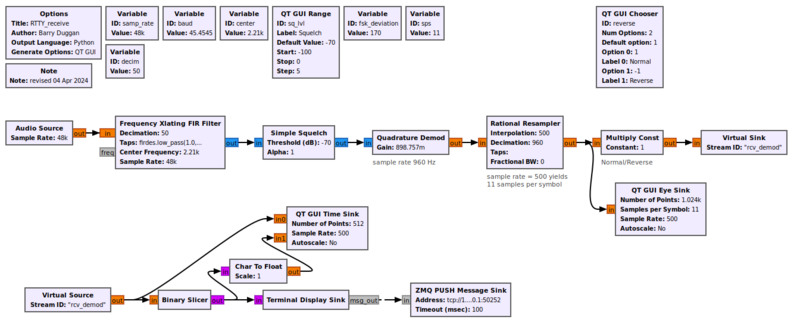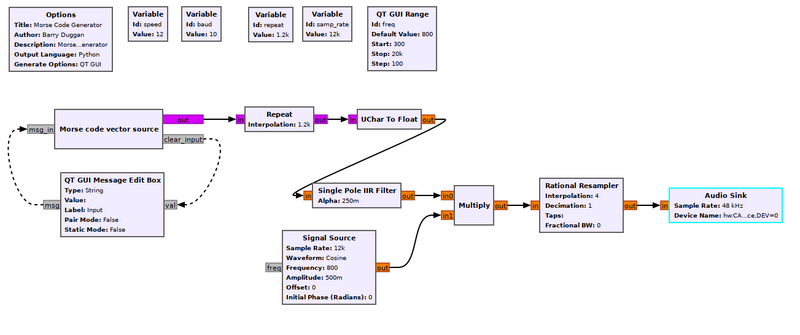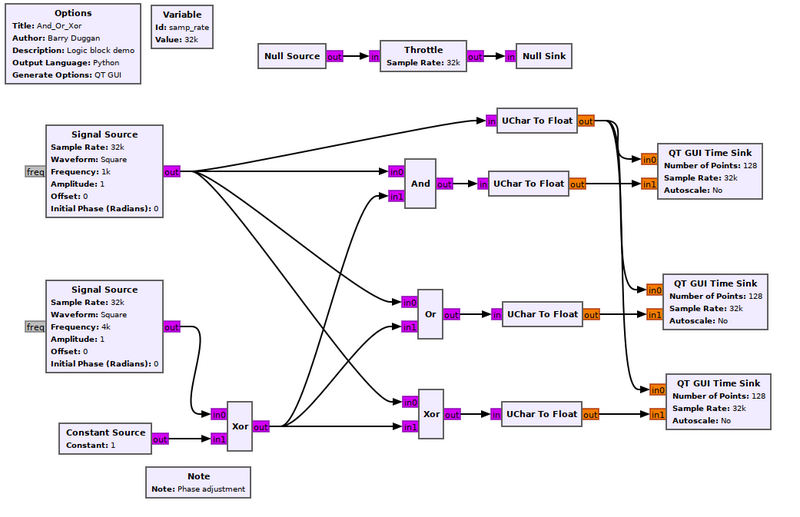Sample Rate Tutorial
Sample Rate Tutorial
Draft - Work in Progress
There are several factors which determine the rate at which data flows from one block to the next. However, many beginners assume that if, for example, a waveform source is set to a certain frequency, and a sample rate is set, then that output signal will be at that rate. But, as opposed to a hardware circuit, the signal is just data in a buffer. The following sections will illustrate this.
Source hardware example
The following discussion is based on this flowgraph:
Frequency shift keying (FSK) tones are input to the microphone jack of the computer which has a sample rate of 48khz. That data is fed to a Frequency Xlating FIR Filter which shifts the tones above and below the center frequency. It also decimates (divides) the sample rate by 50, producing an output sample rate of 960.
The Quadrature Demod produces a signal which is positive or negative depending on whether the tone is above or below the center frequency.
The Rational Resampler interpolates (multiplies) the sample rate by 500 and decimates it by 960 to produce an output sample rate of 500. For the RTTY rate of 45.4545 baud (the exact definition is 1/0.022), this produces exactly 11 samples per bit time.
The 'Terminal Display Sink' is an Embedded Python Block which reads the input stream of 1's and 0's, synchronizes on the start bit, uses a majority of samples in a bit to determine validity, creates a Baudot character from the five data bits, converts Baudot to UTF-8, and displays the characters on the user terminal screen.
Sink hardware example
Whereas the example above is fairly straight forward, timing controlled by a hardware sink must be analyzed by starting at the output and working backwards through the flowgraph.
The following discussion is based on this flowgraph:
For this example, the output Audio Sink has a sample rate of 48khz. This is fed by a Rational Resampler which interpolates (multiplies) the sample rate by 4, so the input sample rate must be 12000.
The Multiply, IIR Filter, and Uchar to Float blocks do not change the sample rate.
The Repeat block takes each data item of input and repeats it 1200 times. This creates an input sample rate of 10, which is the desired baud rate. To provide for various code speeds, Variable blocks define the following:
The speed variable in words per minute can be set by the user to any of the following: 2, 3, 4, 6, 8, 12, 16, or 24 (all are factors of 48).
The baud variable = speed / 1.2
The repeat variable is fixed at 1200.
The samp_rate variable = baud * repeat
The 'Morse code vector source' is an Embedded Python Block which gets characters from the 'QT GUI Message Edit Box' and converts them into vectors, where each 1 is a dot bit time and each 0 is a space of one bit time. The complete description of Morse Code is here [1].
When there is no hardware block
Some flowgraphs, such as for testing or simulation, do not involve any hardware devices to set a sample rate. In those cases a Throttle block can be used instead.
This flowgraph shows the usage of AND, OR, and XOR logic blocks. Since no hardware devices are involved, the Throttle block assures that the processor will not lock up trying to process the data at the maximum possible speed.
Note that the Throttle block doesn't even need to be in the 'main' data path to work.


